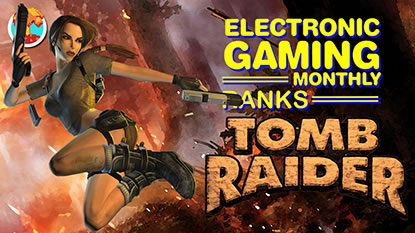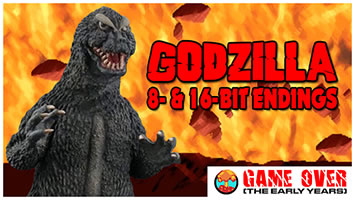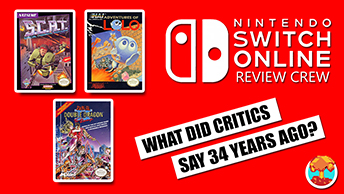- CLASSIC MAGAZINES
- REVIEW CREW
A show recapping what critics thought back
when classic games first came out! - NEXT GENERATION'S BEST & WORST
From the worst 1-star reviews to the best
5-stars can offer, this is Next Generation! - NINTENDO POWER (ARCHIVE)
Experience a variety of shows looking at the
often baffling history of Nintendo Power! - MAGAZINE RETROSPECTIVE
We're looking at the absolutely true history of
some of the most iconic game magazines ever! - SUPER PLAY'S TOP 600
The longest and most ambitious Super NES
countdown on the internet! - THEY SAID WHAT?
Debunking predictions and gossip found
in classic video game magazines! - NEXT GENERATION UNCOVERED
Cyril is back in this spin-off series, featuring the
cover critic review the art of Next Generation! - HARDCORE GAMER MAGAZING (PDF ISSUES)
Download all 36 issues of Hardcore Gamer
Magazine and relive the fun in PDF form!
- REVIEW CREW
- ELECTRONIC GAMING MONTHLY
- ELECTRONIC GAMING MONTHLY RANKS
From Mario to Sonic to Street Fighter, EGM
ranks classic game franchises and consoles! - ELECTRONIC GAMING MONTHLY BEST & WORST
Counting down EGM’s best and worst reviews
going year by year, from 1989 – 2009! - ELECTRONIC GAMING BEST & WORST AWARDS
11-part video series chronicling the ups and
downs of EGM’s Best & Worst Awards!
- ELECTRONIC GAMING MONTHLY RANKS
- GAME HISTORY
- GAME OVER: STORY BREAKDOWNS
Long-running series breaking down game
stories and analyzing their endings! - A BRIEF HISTORY OF GAMING w/ [NAME HERE]
Real history presented in a fun and pithy
format from a variety of game historians! - THE BLACK SHEEP
A series looking back at the black sheep
entries in popular game franchises! - INSTANT EXPERT
Everything you could possibly want to know
about a wide variety of gaming topics! - FREEZE FRAME
When something familiar happens in the games
industry, we're there to take a picture! - I'VE GOT YOUR NUMBER
Learn real video game history through a series
of number-themed episodes, starting at zero! - GREAT MOMENTS IN BAD ACTING
A joyous celebration of some of gaming's
absolute worst voice acting!
- GAME OVER: STORY BREAKDOWNS
- POPULAR SHOWS
- DG NEWS w/ LORNE RISELEY
Newsman Lorne Riseley hosts a regular
series looking at the hottest gaming news! - REVIEW REWIND
Cyril replays a game he reviewed 10+ years
ago to see if he got it right or wrong! - ON-RUNNING FEUDS
Defunct Games' longest-running show, with
editorials, observations and other fun oddities! - DEFUNCT GAMES QUIZ (ARCHIVE)
From online quizzes to game shows, we're
putting your video game knowledge to the test!- QUIZ: ONLINE PASS
Take a weekly quiz to see how well you know
the news and current gaming events! - QUIZ: KNOW THE GAME
One-on-one quiz show where contestants
find out if they actually know classic games! - QUIZ: THE LEADERBOARD
Can you guess the game based on the classic
review? Find out with The Leaderboard!
- QUIZ: ONLINE PASS
- DEFUNCT GAMES VS.
Cyril and the Defunct Games staff isn't afraid
to choose their favorite games and more! - CYRIL READS WORLDS OF POWER
Defunct Games recreates classic game
novelizations through the audio book format!
- DG NEWS w/ LORNE RISELEY
- COMEDY
- GAME EXPECTANCY
How long will your favorite hero live? We crunch
the numbers in this series about dying! - VIDEO GAME ADVICE
Famous game characters answer real personal
advice questions with a humorous slant! - FAKE GAMES: GUERILLA SCRAPBOOK
A long-running series about fake games and
the people who love them (covers included)! - WORST GAME EVER
A contest that attempts to create the worst
video game ever made, complete with covers! - LEVEL 1 STORIES
Literature based on the first stages of some
of your favorite classic video games! - THE COVER CRITIC
One of Defunct Games' earliest shows, Cover
Critic digs up some of the worst box art ever! - COMMERCIAL BREAK
Take a trip through some of the best and
worst video game advertisements of all time! - COMIC BOOK MODS
You've never seen comics like this before.
A curious mix of rewritten video game comics!
- GAME EXPECTANCY
- SERIES ARCHIVE
- NINTENDO SWITCH ONLINE ARCHIVE
A regularly-updated list of every Nintendo
Switch Online release, plus links to review! - PLAYSTATION PLUS CLASSIC ARCHIVE
A comprehensive list of every PlayStation
Plus classic release, including links! - RETRO-BIT PUBLISHING ARCHIVE
A regularly-updated list of every Retro-Bit
game released! - REVIEW MARATHONS w/ ADAM WALLACE
Join critic Adam Wallace as he takes us on a
classic review marathon with different themes!- DEFUNCT GAMES GOLF CLUB
Adam Wallace takes to the links to slice his way
through 72 classic golf game reviews! - 007 IN PIXELS
Adam Wallace takes on the world's greatest spy
as he reviews 15 weeks of James Bond games! - A SALUTE TO VAMPIRES
Adam Wallace is sinking his teeth into a series
covering Castlevania, BloodRayne and more! - CAPCOM'S CURSE
Adam Wallace is celebrating 13 days of Halloween
with a line-up of Capcom's scariest games! - THE FALL OF SUPERMAN
Adam Wallace is a man of steel for playing
some of the absolute worst Superman games! - THE 31 GAMES OF HALLOWEEN
Adam Wallace spends every day of October afraid
as he reviews some of the scariest games ever! - 12 WEEKS OF STAR TREK
Adam Wallace boldly goes where no critic has
gone before in this Star Trek marathon!
- DEFUNCT GAMES GOLF CLUB
- DAYS OF CHRISTMAS (ARCHIVE)
Annual holiday series with themed-episodes
that date all the way back to 2001!- 2015: 30 Ridiculous Retro Rumors
- 2014: 29 Magazines of Christmas
- 2013: 29 Questionable Power-Ups of Christmas
- 2012: 34 Theme Songs of Christmas
- 2011: 32 Game Endings of Christmas
- 2010: 31 Bonus Levels of Christmas
- 2009: 30 Genres of Christmas
- 2008: 29 Controls of Christmas
- 2007: 34 Cliches of Christmas
- 2006: 33 Consoles of Christmas
- 2005: 32 Articles of Christmas
- 2004: 31 Websites of Christmas
- 2003: 29 Issues of Christmas
- 2002: 28 Years of Christmas
- 2001: 33 Days of Christmas
- NINTENDO SWITCH ONLINE ARCHIVE
- REVIEW ARCHIVE
- FULL ARCHIVE
The Day Capcom Gave Sega the Shaft
Street Fighter II was big business in 1993. In fact, the franchise was so big that many games journalists believed it would break the 16-bit war wide open. In today's episode of A Brief History of Gaming, we're taking a look back at a time when Capcom punched Sega in the gut. While it all worked out in the end, this lurid tale suggests that making promises can sometimes lead to PR disaster.
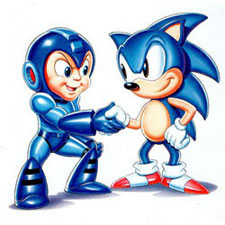
Mega Man and Sonic the Hedgehog BFFs in 1993!
Do you see that picture to the right? This is a picture of Mega Man and Sonic the Hedgehog in 1993, just a few months before the release of Street Fighter II: Special Champion Edition. This was a happy time; Capcom and Sega were finally teaming up. It was the moment Genesis owners had been waiting for. But it was only a matter of time before somebody had to screw it up. This is the story of how Capcom gave Sega the shaft.
It's important to remember that there weren't many multi-platform third-party publishers in the 8-bit era. If you wanted a Capcom game, you either owned a Nintendo console or you waited for another company to port it to a competing system. This was the case with Strider, Ghouls 'N Ghosts, and Forgotten Worlds, three Capcom arcade games that Sega reprogrammed for their 16-bit Genesis.
Although a few games managed to hit Sega's consoles, most of Capcom's library was exclusive to Nintendo. The NES was the only home console where you could experience a long list of Mega Man games, Bionic Commando and the 194X series. And don't forget about the top-rated Disney licensed games, including DuckTales, Rescue Rangers and Tale Spin. Capcom was a major force on the Nintendo Entertainment System, and it was one of many reasons why the Sega Master System had a hard time competing.
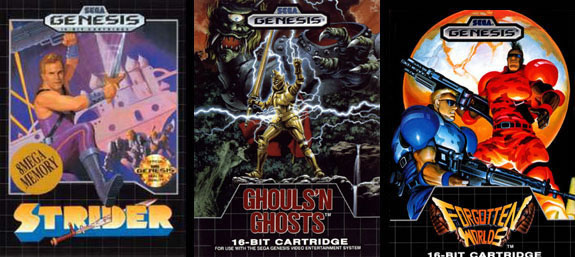
This divide seemed to only get worse in 1992, when Capcom announced that the biggest arcade game in a decade was about to become a Super Nintendo exclusive. Street Fighter II was more than just another game, it was a phenomenon that single-handedly kickstarted the fighting genre. And with magazines spending months hyping the home release, the Super NES was poised to take a commanding lead in the 16-bit war.
But instead of letting this spiral out of control, Sega worked behind the scenes to pull off what many considered to be impossible -- turn Capcom into a third-party Genesis publisher. The plan worked, and in early 1993, Sega and Capcom came together to announce a brand new Street Fighter II game called Special Champion Edition.
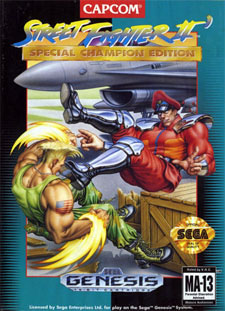
Street Fighter II: Special Champion Edition eventually came out, but not before angering Sega fans!
Based on the newly released Champion Edition update in the arcades, this new Street Fighter II installment would allow players to control all four boss characters. Other improvements over the barebones Super NES game included the ability to compete using the same character, swap colors and pull off a number of moves not included in the original Street Fighter II. And best of all, this game was exclusive to the Sega Genesis. Street Fighter II: Special Champion Edition was scheduled to be released in June, finally giving Sega fans something to get excited about.
Unfortunately, this brand new Genesis game suffered a lengthy delay. Instead of coming out in summer, Special Champion Edition got moved to September 27, 1993. But as disappointing as the delay was, it was nothing compared to Capcom's next move.
After pushing the Genesis game back, Capcom announced that the Super NES would be getting another Street Fighter II exclusive. This time it was Street Fighter II Turbo, based on an even newer version of the arcade game. This game was faster, offered more moves and was significant rebalancing. It was the ultimate version, and it was only coming to Nintendo's console.
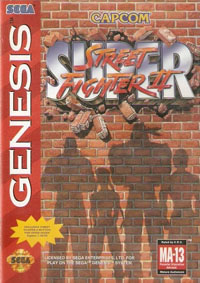
And then there was Super Street Fighter II!
As if this story couldn't get any worse for Sega fans, Capcom decided to release Street Fighter II Turbo on July 11, 1993, more than two months before Special Champion Edition finally shipped to stores. Sega fans went from having a top-of-the-line exclusive to settling for an outdated and inferior product. Sega got the shaft.
One year later, Capcom apologized by releasing Super Street Fighter II at the same time on both Super NES and Genesis. But the critics weren't as keen on this fourth installment and fans were beginning to grow wary of the annual Street Fighter updates. Capcom turned what should have been a unifying moment into a punch in the gut, and it was going to take more than another Street Fighter II game to make things right.
Strangely enough, Capcom pulled a very similar stunt three years after the Special Champion Edition debacle. As excited as many PlayStation owners were to finally get a DarkStalkers port, the feeling was diminished the moment they realized the sequel hit Sega's Saturn a month earlier. But that's a story for another time.

Mega Man and Sonic the Hedgehog BFFs in 1993!
It's important to remember that there weren't many multi-platform third-party publishers in the 8-bit era. If you wanted a Capcom game, you either owned a Nintendo console or you waited for another company to port it to a competing system. This was the case with Strider, Ghouls 'N Ghosts, and Forgotten Worlds, three Capcom arcade games that Sega reprogrammed for their 16-bit Genesis.
Although a few games managed to hit Sega's consoles, most of Capcom's library was exclusive to Nintendo. The NES was the only home console where you could experience a long list of Mega Man games, Bionic Commando and the 194X series. And don't forget about the top-rated Disney licensed games, including DuckTales, Rescue Rangers and Tale Spin. Capcom was a major force on the Nintendo Entertainment System, and it was one of many reasons why the Sega Master System had a hard time competing.

This divide seemed to only get worse in 1992, when Capcom announced that the biggest arcade game in a decade was about to become a Super Nintendo exclusive. Street Fighter II was more than just another game, it was a phenomenon that single-handedly kickstarted the fighting genre. And with magazines spending months hyping the home release, the Super NES was poised to take a commanding lead in the 16-bit war.
But instead of letting this spiral out of control, Sega worked behind the scenes to pull off what many considered to be impossible -- turn Capcom into a third-party Genesis publisher. The plan worked, and in early 1993, Sega and Capcom came together to announce a brand new Street Fighter II game called Special Champion Edition.

Street Fighter II: Special Champion Edition eventually came out, but not before angering Sega fans!
Unfortunately, this brand new Genesis game suffered a lengthy delay. Instead of coming out in summer, Special Champion Edition got moved to September 27, 1993. But as disappointing as the delay was, it was nothing compared to Capcom's next move.
After pushing the Genesis game back, Capcom announced that the Super NES would be getting another Street Fighter II exclusive. This time it was Street Fighter II Turbo, based on an even newer version of the arcade game. This game was faster, offered more moves and was significant rebalancing. It was the ultimate version, and it was only coming to Nintendo's console.

And then there was Super Street Fighter II!
One year later, Capcom apologized by releasing Super Street Fighter II at the same time on both Super NES and Genesis. But the critics weren't as keen on this fourth installment and fans were beginning to grow wary of the annual Street Fighter updates. Capcom turned what should have been a unifying moment into a punch in the gut, and it was going to take more than another Street Fighter II game to make things right.
Strangely enough, Capcom pulled a very similar stunt three years after the Special Champion Edition debacle. As excited as many PlayStation owners were to finally get a DarkStalkers port, the feeling was diminished the moment they realized the sequel hit Sega's Saturn a month earlier. But that's a story for another time.
HOME |
CONTACT |
NOW HIRING |
WHAT IS DEFUNCT GAMES? |
NINTENDO SWITCH ONLINE |
RETRO-BIT PUBLISHING
Retro-Bit |
Switch Planet |
The Halcyon Show |
Same Name, Different Game |
Dragnix |
Press the Buttons
Game Zone Online | Hardcore Gamer | The Dreamcast Junkyard | Video Game Blogger
Dr Strife | Games For Lunch | Mondo Cool Cast | Boxed Pixels | Sega CD Universe | Gaming Trend
Game Zone Online | Hardcore Gamer | The Dreamcast Junkyard | Video Game Blogger
Dr Strife | Games For Lunch | Mondo Cool Cast | Boxed Pixels | Sega CD Universe | Gaming Trend
Copyright © 2001-2025 Defunct Games
All rights reserved. All trademarks are properties of their respective owners.
All rights reserved. All trademarks are properties of their respective owners.













